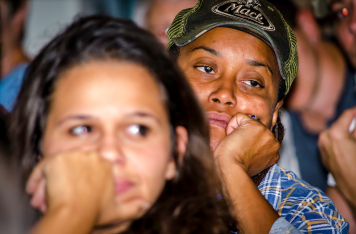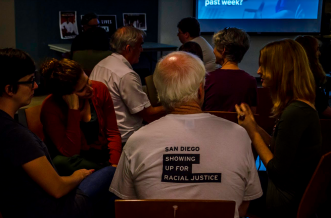
Story and photos by Byron Croft
Shooting sparks broader conversation on police-citizen relations in East County and San Diego, facilitated by Showing Up for Racial Justice (SURJ)
October 14, 2016 (El Cajon) -- The recent shooting of Alfred Olango in El Cajon has sparked a surge of conversation on the topic of how police handle people in some sort of mental distress, and how that handling may sometimes be different when the people police encounter happens to be with someone with skin darker than “white.” What for many, until recently, was viewed as a concern for those in larger cities, such as Chicago and New York, has now become a topic of discussion in East County, and surrounding San Diego.
As more police departments across America begin tabulating data on the race of the subjects of police encounters, it is becoming more apparent that the darker one’s skin happens to be, the more likely one is to encounter the police, despite factual innocence or guilt of any crimes.
In 2011, at the height of New York’s ”Stop and Frisk” policy recently ruled by the Supreme Court as unconstitutional, there were just shy of 700,000 “Stop and Frisk” encounters, where over 88% of those encounters produced no evidence of a crime committed. That means more than 600 THOUSAND people were detained and searched, although they had done nothing wrong. Almost nine out of every ten stops were innocent people, detained for no reason.
More alarming, however, may be that more than three times the entire population of all of San Diego, a little over 4.4 MILLION people in New York, were stopped and frisked between 2004 and early 2012, but of those more than 4.4 MILLION people, nearly 90% were described as black or Latino. In Philadelphia, where a similar “Stop and Frisk” program is in effect, subjects described as “African-American” comprised nearly 70% of encounters.
Again, nine out of ten stops were black or Latino, and nine out of ten stops were people who had done nothing wrong.
Despite a highly propagandized yet largely fictitious “War on Police”, according to both the U.S. Department of Justice, and the U.S. Bureau of Labor Statistics, it has never been a safer time to be a cop. In fact, police fatalities are down, historically, and most on-duty deaths occur as a result of traffic accidents, followed by heart attack or other health-related issues. Correlating with this trend is a decline in violent crimes and murder, nationwide, with exceptions in a couple cities.
 The same cannot be said for citizen encounters, however. In a trend opposing a reduction in violent crime, and police injuries and fatalities, we have seen an uptick, year after year, in citizen injuries at the hands of police, and in reports of excessive force complaints, and police shootings, especially disturbingly, of unarmed individuals.
The same cannot be said for citizen encounters, however. In a trend opposing a reduction in violent crime, and police injuries and fatalities, we have seen an uptick, year after year, in citizen injuries at the hands of police, and in reports of excessive force complaints, and police shootings, especially disturbingly, of unarmed individuals.
According to some studies, one is between eight and eleven times more likely to be killed by the police than by a terrorist attack. It’s not hard to imagine that the likelihood increases, the darker one’s skin happens to be.
Shootings like the recent one in El Cajon have brought this topic to the forefront of discussion. In fact, since the early 1980s, there have been over 600 citizens killed by police in San Diego County.
These issues have seen an emergence of activism and police accountability groups that largely focus on issues of police corruption and brutality. Another group, however, has taken a different tack, and is focused on raising awareness among “white people.”
SURJ, which stands for Showing Up for Racial Justice, a nation-wide organization, has made a mission out of “Moving white people to action with passion and accountability.” What first might strike one as odd to have an entire organization geared toward motivating “white people,” begins to make a bit more sense when speaking with the San Diego chapter’s leadership. As the organization points out, because most police encounters are in the poorest of neighborhoods, and the majority of those residents are “people of color”; it stands to reason that most police encounters are with people who aren’t “white”, and the statistics that are beginning to be tracked back that assertion.
“When the majority of white people have positive encounters with the police, and more policing is done in neighborhoods populated with people of color, it’s easy to see why a good deal of white people don’t recognize issues of police brutality or killings the same way those people of color might see them,” explained one of the SURJ activists at an impromptu meeting on October 6th in La Mesa, in response to the shooting of Alfred Olango, a black immigrant, living in El Cajon.
When this reporter interviewed Catherine Mendonca, the person in charge of communications with the group “United Against Police Terror - San Diego”, a grassroots accountability organization that tracks citizens killed by police and offers support to their families, she had a correlating opinion. “It’s not so much that white people are apathetic, it’s that there seems to be a lack of empathy. They [white people] seem unable to relate to the disparity of policing involved with non-whites. Until it happens to them, or they witness it first-hand, police brutality or corruption doesn’t exist. Programs like SURJ are probably important in helping solve that problem, though I’d like to see those organizations also be more involved in protest, and helping white people get on the front lines, or even stand between police and protesters of color.”
Another of the community meeting’s attendees, Keesia Thomas, added “I believe race absolutely played a role in Alfred Olango’s death. If the cops rolled up and there was a little, blonde girl, saying her daddy needed help, I don’t think they [the police] would’ve approached guns already drawn, and boxed him in like that. I don’t know why there wasn’t an attempt to talk to him and de-escalate the situation.”
Another local resident, who wished to only be identified as Sara, expressed frustration with the handling of the situation. “When someone calls for help, they don’t want to get shot. Police are not equipped to deal with someone in mental distress or mental illness. The only thing the police understand is force and enforcement. When you call 911 for medical reasons, you should get medical help, not someone approaching you with a gun.”
Throughout the commentary during the community meeting, there seemed to be a consensus among the majority of attendees that the police response, closing in on someone having a mental crisis with weapons drawn, and boxing him in, unnecessarily provoked Olango, and needlessly escalated the situation; however, once Olango pulled out what was later determined to be a vaping device, and assumed a “shooting stance”, most could see the shooting as not surprising, if not justified.
“I understand why he was shot. We’ll never know went through the officer’s mind. He may have been scared, maybe not. But I still don’t think it should’ve even got to that point” opined another speaker at the meeting who wished to remain unnamed.
East County Magazine had the opportunity to interview Melanie [who declined to give her last name], the head of the Communications Team for SURJ San Diego:
East County Magazine (ECM): If one were to boil it down, what is the primary focus of SURJ?
Melanie (M): SURJ is a national network of groups and individuals organizing white people for racial justice. Through community organizing, mobilizing, and education, SURJ moves white people to act as part of a multi-racial majority for justice with passion and accountability. We work to connect people across the country while supporting and collaborating with local and national racial justice organizing efforts. SURJ provides a space to build relationships, skills, and political analysis to act for change.
We envision a society where we struggle together, with love, for justice, human dignity, and a sustainable world.
ECM: How are you funded; and, how are those funds, primarily, used?
M: We aren’t funded. Everything we do is 100% volunteer. We do accept donations. Donations allow us to do things like buy a domain name or projector adapters without having our steering committee constantly financially tapped.
When we do receive donations, 50% goes to a People of Color -led organization in San Diego, as per the mandate of SURJ National.
ECM: What do you feel the general consensus is toward the shooting of Alfred Olango?
M: I wish I could give you a couple sentences on the ‘consensus’ with Alfred’s death, but life isn’t that easy, is it?
ECM: When looking at the data, a sizeable portion of victims of police homicide have some sort of mental illness, or are in a state of mental distress or diminished capacity. Are police capable of dealing with people who have mental health issues?
M: I think you should ask law enforcement officials how they feel they are equipped to handle mental health emergencies. The data, however, doesn’t point to law enforcement being the best first response to a medical psychiatric emergency.
ECM: Does America have a police problem? If so, what can be done about any such problems?
M: The last two questions? Friend, I encourage you to seek out those answers yourself. Be part of the solution… and two more words: Shaun King
ECM: So you have no comment on whether or not America has a police problem? Or if so, what any possible solutions may be?
M: People have written volumes on policing and police reform. Shaun King has a 25-part series. Michelle Alexander wrote a book on it. Countless activists, scholars, and leaders have been working on and around policing in the United States for decades. Look to those voices. We should all be students of justice and freedom…
… In the words of Dr. Cornel West, “Justice is what love looks like in public.”
ECM: So you, personally, don’t have an opinion on it? Just other people’s?
M: It’s not that I don’t have opinions, it’s that I’m a student in racial justice, and I’d rather point to the teachers. My job is to learn, listen, and act. I absolutely encourage others to do the same.
---
Melanie from SURJ reports growing attendance at their twice monthly workshops on the 2nd and 4th Thursdays of the month.
On October 27th, SURJ is hosting a workshop on voting for social justice at 6:30 PM in the San Diego Public Library College - Rolando Branch located at 6600 Montezuma RD 92115
SURJ has a website located at: www.showingupforracialjustice.org
And a facebook page at: www.facebook.com/surjsandiego
United Against Police Terror - San Diego’s facebook page is: www.facebook.com/uaptsd







Recent comments